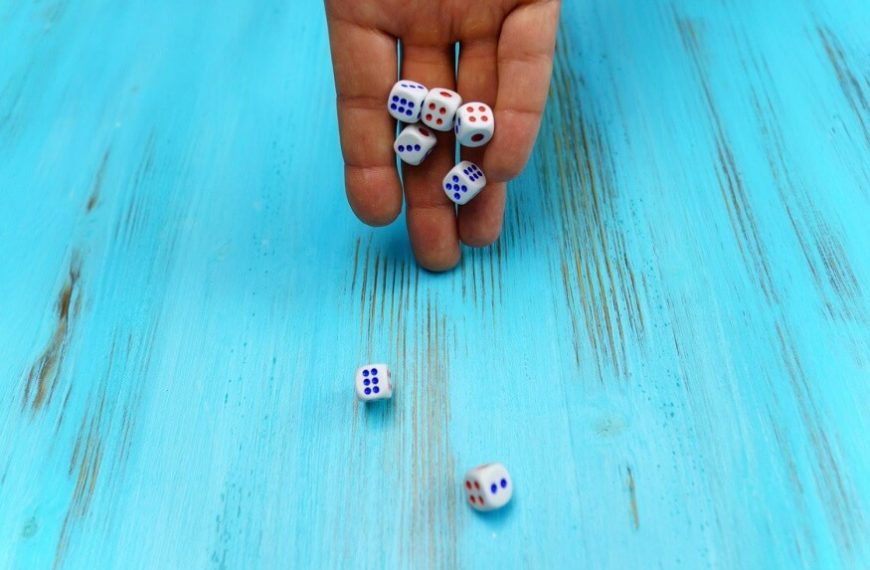A simple dice is amazingly versatile when it comes to creating a whole new world of learning for kindergarteners through fun dice games. Buying a dice is not even necessary and you can just make one out of a building block and use it for a plethora of simple and engaging activities which cover many areas like mathematical calculations, critical skills, probability analysis, deduction, fine motor skills and literacy skills.
Little kindergarteners love dice and adding them to games and activities makes a simple game all the more exciting. It hones their counting skills and is a good way to keep them entertained at home if they cannot go outdoors to play and is a good replacement for screen time as well. It’s also great to enhance sportsman spirit and social skills. Let’s look at some different ways you can use dice games for kids to enhance engagement during lessons or recess.
- Whack the Dough
- Whack The Dough Subtraction
- Pasta Race
- Going to Boston
- Transitional Art – Stories
- Beat That
- Dance Counting
- Knock Out!
- Building Towers
- Dice Race
This is a really innovative and fun counting game for which you just need a dice and some playdough. Ask the kindergarteners to make lots of balls, the size of marbles, with dough. Place them on a play tray. This game involves one to six players at a time. One person rolls the dice, the children recognise the number that is rolled and then all the kids start to whack that number of dough balls while counting loudly at the same time. Kids understand that it is one action for one number and it’s great visual, physical and fun activity for early counters.
This is a continuation of the previous game. Ask the children to make 6 to 10 balls of playdough. One child rolls the dice and the number rolled is the number of balls that everyone is going to whack. If they roll a ‘5’, then everyone whacks 5 balls of dough. Then they count the number of balls that are not whacked.
This dice game for kids is a great way to introduce subtraction for the first time and can be repeated for different numbers.
All you need for this game is a lump of dough, a piece of dry spaghetti or skewer and some penne pasta. It’s good to play with 2 to 6 players. Make a ball of playdough and stick the piece of spaghetti in it, so that it stands vertically. Give everyone a pile of pasta and the first player rolls the dice. If they roll a ‘4’ they put 4 pieces of pasta on the spaghetti piece. Then the next player rolls the dice and places that quantity of pasta on the spaghetti. The winner is the child who gets to the top of the spaghetti first.
This activity is good for counting and number recognition as well as problem solving and thinking.
One of the old, classic dice games for kids, it’s simple, entertaining and helps greatly in learning addition. You will need 3 dice and 2 or more players. Roll the 3 dice and keep the highest aside. Repeat with the remaining two dice. Roll the last dice and add up the total for your score. The first player to reach 500 points first is the winner. With older children, you can ask them to multiply the numbers instead of adding them.
A tinker tray of loose parts and a dice is what you need for this fun dice game. You also need a board which is going to be the background for the story. This transitional art dice game is a beautiful combination of early maths and storytelling. Roll the dice and then put that quantity of one loose part on to the board and make up a story. So you might roll a ‘4’ and put 4 leaves on the board. You could say, “One day four yellow leaves fell from the tree.” Then roll again and if you get a ‘3’, you could put 3 feathers on the board, and say, “Three small children saw them and picked them up.” you can go on like this and build a story.
This is one of the family fund dice games that children adore. It requires 2 or more people and 2 dice. Each player rolls both the dice and the number facing upwards is the player’s score. For example, if one dice has 3 and the other has 4, the player’s score is 34. The dice is passed to the next player by the first player who says, “Beat that!” The next player should then try to get a combination that is greater than 34. Whoever gets the highest combination is the winner. You can create a variation by adding up the numbers and whoever reaches 1000 first is the winner. The number of dice can also be increased according to the age of the players.
All you need for this is a dice, some peppy music and a simple dance routine with about 4 to 5 different movements in a sequence. Practise the routine with the children. Roll the dice and whatever number your kid gets is the number of times they do each movement in the routine. This can be repeated several times with different numbers being rolled out.
This is one of the classic dice games that’s simple and exciting. It needs 2 to 6 players and each player needs one dice. One player starts the game and whatever number they roll out is the ‘knock-out’ number. After that, everyone rolls their dice and if they roll the ‘knock-out’ number they are out. If any other number is rolled out the players are still in the game and continue. The winner is the last person left at the end.
This is a game with 2 players and ten dice each. The aim is to create 4 towers each that go up from 1 to 5. Both players roll their ten dice and look for 1s. If they roll any 1s they are removed to start building the towers of dice. When you have four 1s as the foundation of your 4 towers, then start adding 2s and then 3s to the towers. At the end you will have 4 towers, with the numbers 1 to 5 in sequence. Whoever finishes first is the winner.
Each player starts with six dice and the aim is to roll the dice and get a ‘1’. As soon as a ‘1’ is rolled, that dice is put aside and they aim to roll a ‘2’. Whoever gets all six dice from 1 to 6 first, is the winner.
Dice games for kids can be used to supplement maths activities, build social skills and reinforce kindergarten learning. It also ensures that they have loads of fun while gaining knowledge or just gives them some play time with their friends or family. Visit EuroKids for more such engaging blogs.
















